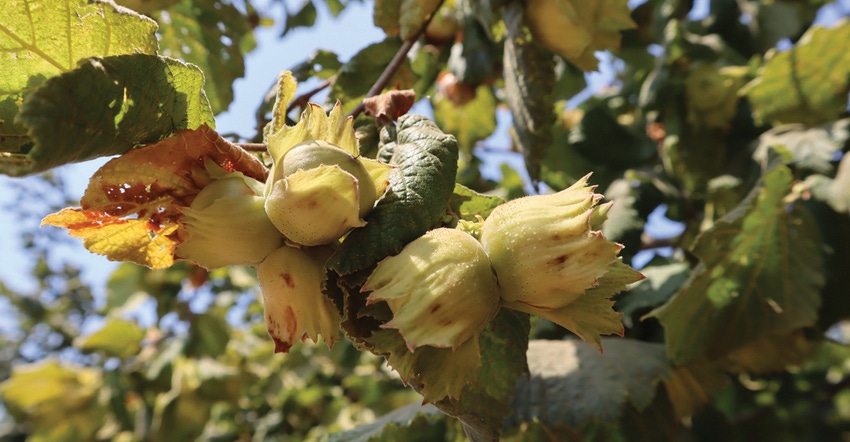
Almonds, pecans, walnuts, and pistachios flew off trees throughout California nut country as part of the annual harvest. Now, a bit further north in the Pacific Northwest, the hazelnut harvest has reached full momentum, a later event for growers there.
Harvest started a few days earlier than usual, but once underway, it turned into a round-the-clock procedure that began with fine-tuning equipment so that sweepers could go through the field and blow the filberts into windrows before they got vacuumed into totes and shipped off in semis.
Ryan Flaherty, grower relations manager for Hazelnut Growers of Oregon, said it won’t be until about Thanksgiving when the last nuts are harvested. “There was a lot of cleanup of older varieties, Barcelona and Ennis, that got battered during the Valentine’s Day freeze and then hit again in June with a three-day, 115-degree, heat wave. It will be difficult to determine just exactly the damage done until we get into full harvest. I’ve gone sampling and cracked out a few kernels, but there’s been no report yet that measures defects, decay, mold, or yield because stuff has just recently started to fall to the ground.”
This was an unusual year for hazelnut growers who began optimistically enough with successful pollination and a good bloom before some trees lost limbs and cracked in half or toppled over under the weight of that late spring ice damage. Once a semblance of normalcy returned to the schedule, this year’s crop became a part of a lengthy history of a nut that dates to 2839 B.C. in China where it was listed among the five sacred nourishments bestowed on humans, used both as a medicine and a tonic.
Tradition in the nut world calls for an early report, a Subjective Yield Survey “guesstimate” of what the crop will be, which is followed by a later season Objective Yield Survey as growers close in on actual harvest.
Challenging weather
This year, citing “our challenging weather that led to divergent answers on many survey cards”, the Hazelnut Marketing Board of Oregon decided to stick with the mid-year anticipated harvest figure of 62,600 tons and forget about a follow-up Objective Survey.
In releasing numerical results, they noted, “Some growers projected incremental and exponential growth while others anticipated yield decreases due to early season ice storms followed by extreme heat and drought in the summer months.”
“Viable survey cards were cross-referenced with field mapping statistics from the Pacific Agricultural Survey and when extrapolated out, the projected crop size will be 125,233,017 pounds (equating to 62,603 tons) — which will be a new high for the industry,” they reported.
The reported figures showed some 30,000 acres of mature trees producing 82 million pounds or a yield of 2,710 pounds per acre while nearly 19,000 acres of 5-10-year-old trees were responsible for 33 million pounds at a rate of 1,763 pounds per acre. Another 35,000 acres of youthful plantings (with a tree age ranging from zero to 4 years) resulted in just under 10 million pounds and a yield of 282 pounds per acre.
The Hazelnut Marketing Board in Wilsonville, established in 1949, represents more than 700 farm families who grow 99% of the U.S. hazelnut crop.
Current indications anticipate that growers will receive 2020 pricing on kernel varieties (90 cents per pound) while in-shell pricing is predicted at 80 cents per pound for the 2021 crop, up 15 cents from last year’s minimum. The in-shell minimum price rise was attributed to reduced tariffs on Chinese crops, a trade deal that took effect this year.
Read more about:
HazelnutsAbout the Author(s)
You May Also Like




